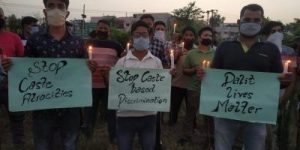Hathras Rape Case: Grappling with Ground Realities of the Implementation SC/ST Prevention of Atrocities Act

As lakhs of people take to the streets to demand justice for Hathras victim, and the many other Dalit women who face unspeakable atrocities, discussions around caste and criminal justice are gaining traction. Legal experts from CENTRE FOR SOCIAL JUSTICE (CSJ) shine the light on some critical challenges faced by grassroots lawyers in using the Scheduled Castes and the Scheduled Tribes (Prevention of Atrocities) Act, 1989 to safeguard justice for victims.
The authors Gayatri Suman, Shobharam Gilhare, Divya Jaiswal, Hemlata Sahu, Rajendra Kumar Banjare, and Tendon Kumar Sahu are lawyers who work with victims of caste atrocities.
This report is the result of a larger study on the implementation of the Act in Chhattisgarh (Kanooni Margdarshan Kendra 2019) conducted by CSJ. While the findings are based on experiences from Chhattisgarh, they speak to a larger failure of the State machinery to protect its most vulnerable and to bring oppressors to justice.
——
THE brutal caste-based gang rape and murder of Hathras victim, a 19-year-old Dalit woman by a group of Thakur men in Hathras, has shocked the nation.
For many Dalit women, however, the reality of caste-based gender violence is unrelenting and unending. Soon after the Hathras atrocity, news of the rape and murder of a 22-year-old Dalit woman in Balrampur and rape of a 13-year old Dalit girl in Telangana, is a testament to this vicious reality.
The covert immolation of the victim in the dead of the night and the blatant lawlessness with which the Uttar Pradesh Government is denying charges of rape, has brought state responses to caste atrocities into sharp focus.
The journey to justice for Dalit and Adivasi women is fraught.
In furtherance of the spirit of Articles 14, 15, and 17 of the Constitution of India, the Scheduled Castes and the Scheduled Tribes (Prevention of Atrocities) Act (Atrocities Act) was introduced in 1989 to prevent caste-based violence and ensure justice for victims. Thirty-one years on, its efficacy in the face of active subversion by state authorities is limited, to say the least.
According to the National Crime Records Bureau data of 2019, almost 13 Dalit and Adivasi women are raped every day in India.
This data, on the number of cases registered under Section 376 IPC along with the Atrocities Act, accounts for a mere fraction of the total number of cases. The reporting of cases that deal with sexual crimes, especially against Dalit and Adivasi women, are extremely low. Moreover, even when cases are reported and registered, it is very challenging to include both IPC and Atrocities Act sections on the FIR. This data does not account for a large number of reported cases of sexual violence against Dalit and Adivasi women where FIRs were registered under IPC Section 376, but not under the Atrocities Act.
Police require caste certificate for FIR under the Atrocities Act, but law does not

All criminal processes are set in motion through registration of a First Information Report (FIR).
Upon receiving information of any cognizable offence, the police officer receiving such information is duty-bound to register an FIR. Section 4 of the Atrocities Act reinforces this duty and makes refusal to do so in cases of caste atrocities a criminal offence.
Yet, it is rare for the police to register an FIR under the Atrocities Act in the first instance. In many of our cases, the police have refused to include the Atrocities Act on the FIR in the absence of the victim’s caste certificate.
Aarti (name changed), a 13-year-old girl was raped by an older dominant caste man in her village. An FIR was registered under the Indian Penal Code, 1860 (IPC), and The Protection of Children from Sexual Offences Act, 2012 (POCSO) was filed, but the Atrocities Act was not included in the FIR.
Being from the same village as Aarti, the police officer knew her caste. Yet, he refused to include the Atrocities Act in the FIR since Aarti did not have a caste certificate.
Following Aarti’s case, we filed a Right to Information application seeking a list of documents required for registration of FIR under the Atrocities Act from the Bilaspur Superintendent of Police. The response left no room for doubt: “No documentary evidence is necessary for the registration of FIR under Atrocities Act”.
Moreover, procuring caste certificates is rife with hurdles.
The documentary onus is so high that many, despite being recognised as belonging to a particular caste by the communities they live in, fail to procure a caste certificate
.
As per the Chhattisgarh Scheduled Castes, Scheduled Tribes and Other Backward Classes (Regulation of Social Status Certification) Rules, 2013, the following documents are required for a Scheduled Caste certificate:
1. family tree of three generations,
2. certificate proving that one’s ancestors lived within the geographic limits of Chhattisgarh on or before 10th August 1950 and
3. proof of the father’s caste.
The documentary onus is so high that many, despite being recognised as belonging to a particular caste by the communities they live in, fail to procure a caste certificate.
In Aarti’s case, neither of her parents had any documentary proof of caste. Aarti’s father was brought up by his mother who did not know her son’s paternal ancestors. Despite judicial pronouncements, it is still rare for a caste certificate to be issued on the basis of maternal ancestry.
What do the courts say on registration of FIR under the Atrocities Act?
The law on the registration of FIR under Atrocities Act is unambiguously clear.
The Supreme Court in Lalita Kumari v. Govt. of U.P. (2014) stated that the credibility of information does not have to be determined at the FIR stage. As long as a cognizable offence is “made out” in the information being conveyed to the police officer, an FIR must be registered.
Similarly, in Superintendent Of Police C.B.I. and Ors. v. Tapan Kumar Singh (2003) held that an FIR is “not an encyclopedia”, and thus all relevant facts are not required for its registration.
The Bombay High Court in Dagadu Gorakh Patil and Ors. vs. Shivaji Jethya Walvi (2013), where it was held that the caste of the victim is not a prerequisite for filing an FIR under the Atrocities Act.
In the context of the Atrocities Act, the Supreme Court in Ashabai Machindra Adhagale v. State of Maharashtra (2009) reiterated this position. It held that an application for quashing an FIR was not maintainable solely on the basis that the caste of the accused was not known at the FIR stage.
The logic of Ashabai was taken to its logical conclusion by the Bombay High Court in Dagadu Gorakh Patil and Ors. vs. Shivaji Jethya Walvi (2013), where it was held that the caste of the victim is not a prerequisite for filing an FIR under the Atrocities Act.
The absence of proof of caste can thus by no means be construed as grounds for denying an FIR under the Atrocities Act. The question of the accused’s and victim’s caste, if a question at all, is one that may be determined during the investigation.
Nevertheless, the violence of demanding proof of caste is repeatedly inflicted on victims.
In some cases, police have gone as far as sending a notice to the victim for the production of a caste certificate so that investigation can proceed under the Atrocities Act. Not only does this foreclose the possibility of conviction under the Atrocities Act, but also deprives victims of their rehabilitation and compensation rights under the Act.
Even when the victim has a caste certificate, it is rare for the police to register a case under the Atrocities Act without civil society pressure.
Police tiptoes around Atrocities Act
Even when the victim has a caste certificate, it is rare for the police to register a case under the Atrocities Act without civil society pressure.
In the few cases where the Atrocities Act was registered, the victim was often kept in the dark about the process.
It has become routine practice in some areas for the Inspector of Police to send an FIR registered under IPC to a higher ranked official for inclusion of sections of the Atrocities Act. Police claim that doing so is required under Rule 7 of the Atrocities Act Rules which makes it mandatory for investigations under the Act to be carried out by an “officer not below the rank of a Deputy Superintendent of Police (DySP)”.
On the contrary, Rule 7 makes no mention of registration of FIR. The investigation, which is to be carried out by a DySP ranked officer, begins after registration of FIR. As a consequence of this practice, many victims are not provided with a copy of their FIRs. It is only when they are summoned for trial that they are made aware of the charges against the accused. Naturally, this also denies victims their right to immediate relief and protection during investigation.
Police inaction is criminalised under Section 4 of the Act, which places criminal liability on public servants for negligence and non-performance of duty. However, the space to prosecute police for failure to register an FIR under the Act is also constricted as an administrative sanction is required to prosecute a civil servant.
Moreover, the process for prosecution under Section 4 is mired in confusion.
In some instances, courts have suggested that failure to register an FIR cannot be prosecuted under Section 4 of the Atrocities Act since without an FIR, the provisions of the Act cannot be attracted. This absurd Catch-22 situation has emboldened the authorities to act with complete impunity.
Trial Courts place a higher onus on caste specific intention of crime contrary to law
When, and if, a case reaches trial, securing a conviction under the Atrocities Act is rare.
According to the National Crime Records Bureau, the national conviction rate under the Atrocities Act in 2019 was a mere 31.7%, compared to the national average of 42.2% for cases under the IPC (2020).
A primary reason for this is that Trial Court judges often demand proof from the prosecution that the atrocity was committed because the victim belonged to a Scheduled Caste or Scheduled Tribe. Proving such an intention in a criminal trial, where the standard of proof is beyond a reasonable doubt, is almost impossible.
Considering this, key amendments were brought to the Atrocities Act in 2015.
Post the amendments, the Atrocities Act is applicable if the atrocity was committed “knowing” that the victim belongs to a Scheduled Caste or Scheduled Tribe. It is thus no longer upon the prosecution to prove that the intention was caste-based, the law instead assumes that knowledge of the victim’s caste is enough to establish caste-based intention.
It has been five years since these amendments, but many Trial Court judges continue to apply the old test and demand proof of caste-based intention.
Section 8(c) of the Act further stipulates that where the accused had prior knowledge of the victim or their family, it will be presumed that the accused knew the victim’s caste. This presumption can be rebutted in court, however, the burden of proof is shifted to the accused. Thus, when the victim and accused belong to the same village, work in the same office, or study at the same institution, the law will presume that the accused knew the victim’s caste, and the Atrocities Act will apply.
It has been five years since these amendments, but many Trial Court judges continue to apply the old test and demand proof of caste-based intention. Then, based on a lack of evidence to prove intention, they continue to acquit accused parties.
Public Prosecutors similarly fail to raise the post-2015 position of law before the Court. If convicted, this is usually under the Indian Penal Code and rarely under the Atrocities Act. In two of our cases, as recent as 2017 and 2018, both accused parties testified to knowing the caste of the victim in court. However, the Court concluded that neither of them committed the offence on the basis of the victim’s caste and acquitted both. One of these cases is currently pending in the High Court.
It is of note here that Judges and Public Prosecutors who deal with Atrocities Act cases are specifically appointed for cases under this Act. That they, either negligently or willfully, continue to make such basic legal errors despite special training speaks volumes.
(The authors are lawyers and paralegals associated with the Chhattisgarh Unit of the Centre for Social Justice and are actively involved in providing legal representation to marginalised communities in rural Chhattisgarh. Over the years, they have supported numerous victims of caste atrocities through the legal process. They may be contacted at kmk36garh@gmail.com. Views are personal.)
The article was originally published in The Leaflet.
Get the latest reports & analysis with people's perspective on Protests, movements & deep analytical videos, discussions of the current affairs in your Telegram app. Subscribe to NewsClick's Telegram channel & get Real-Time updates on stories, as they get published on our website.
























